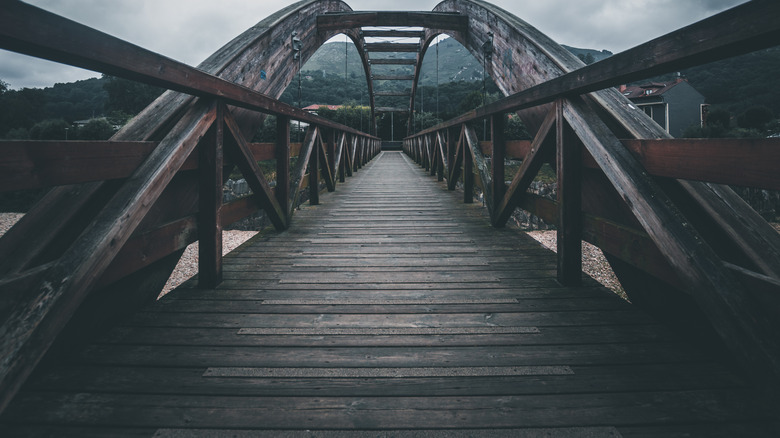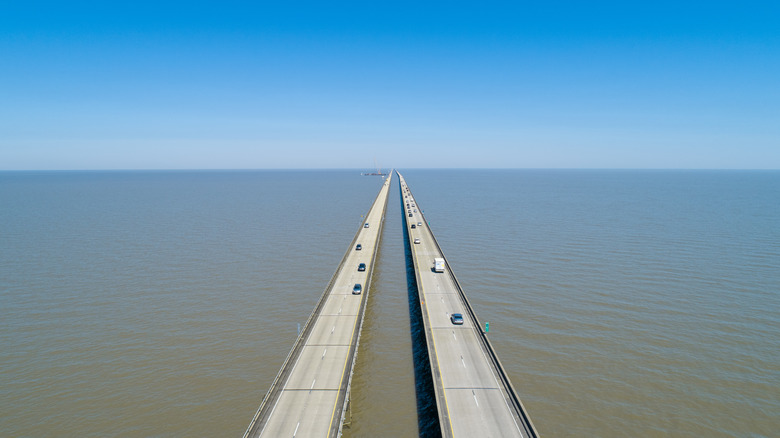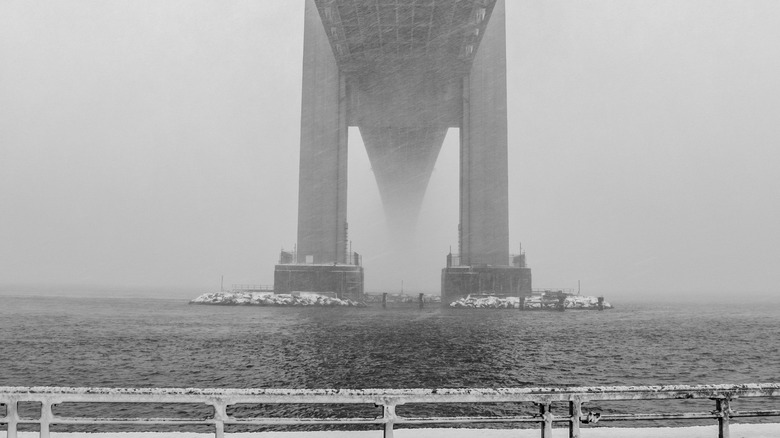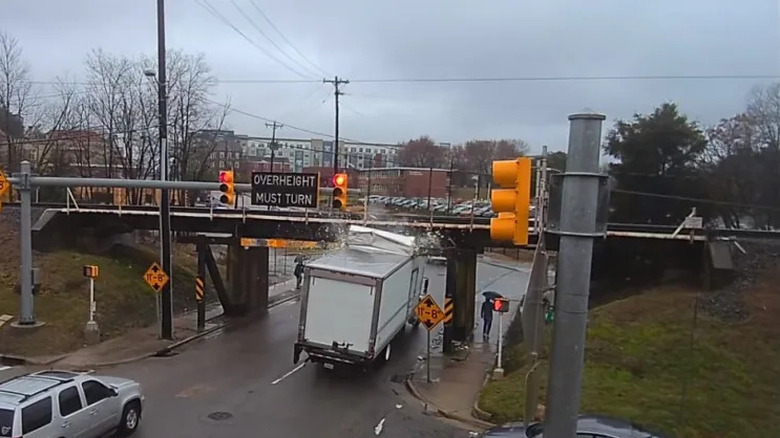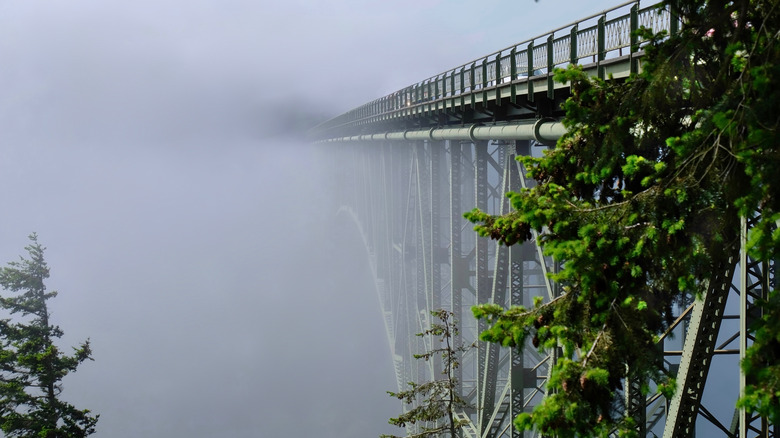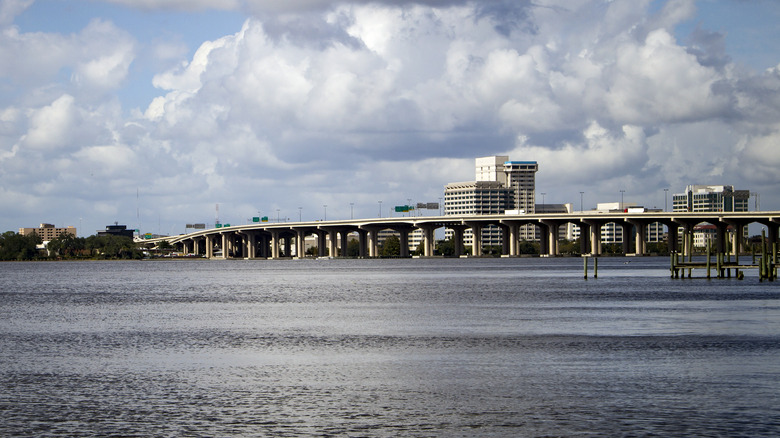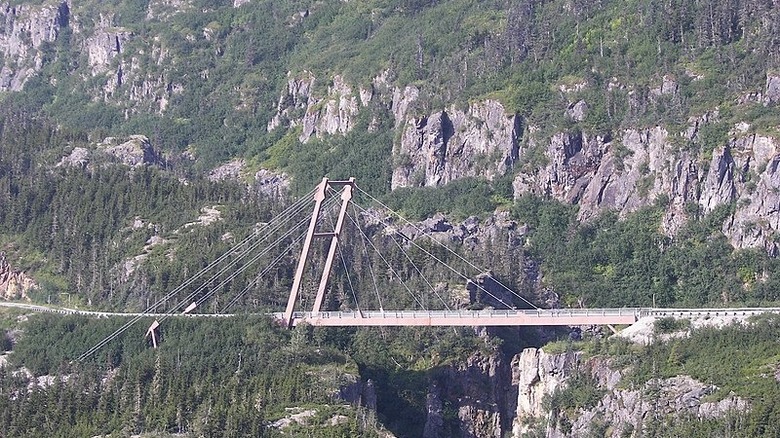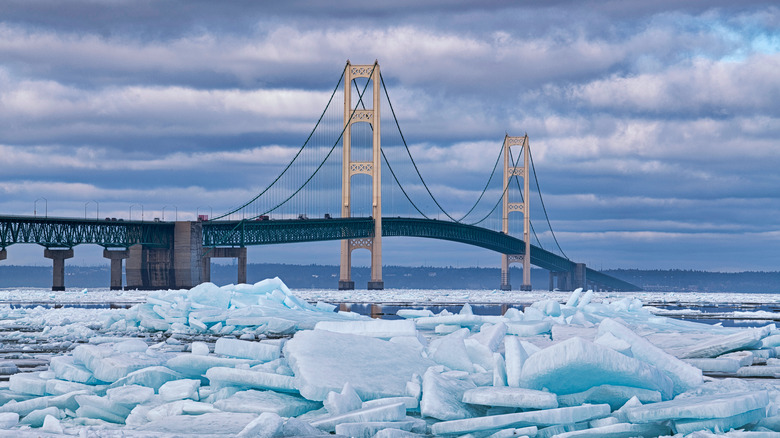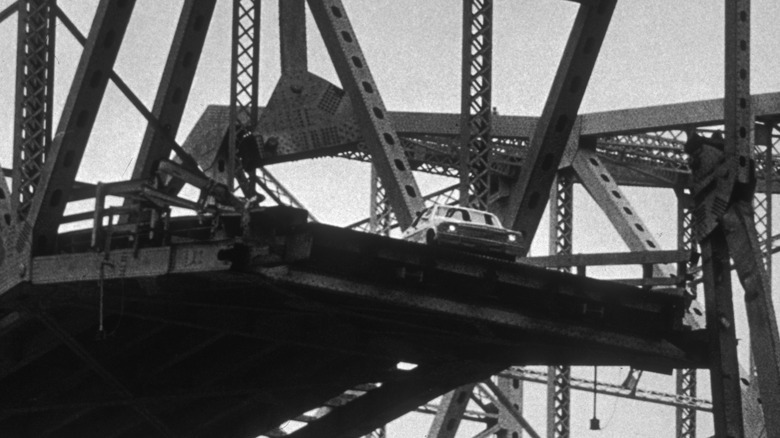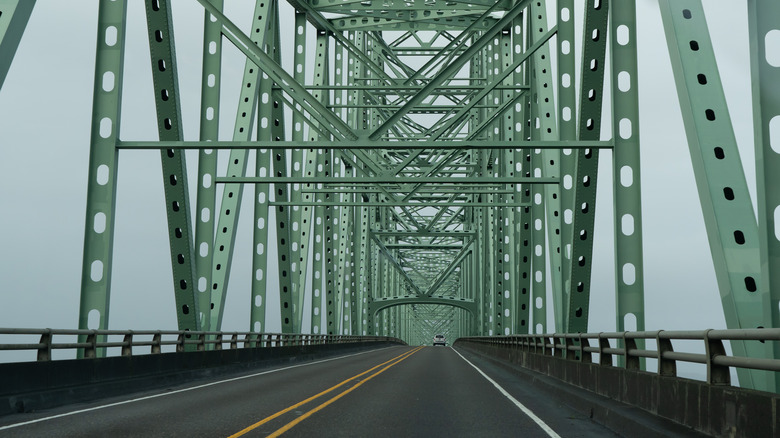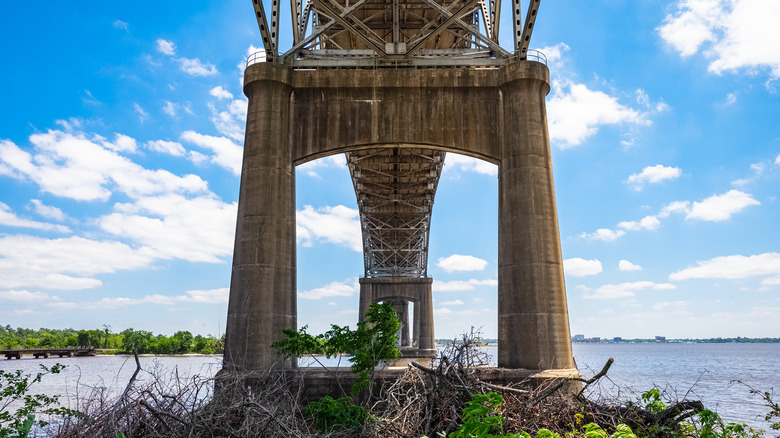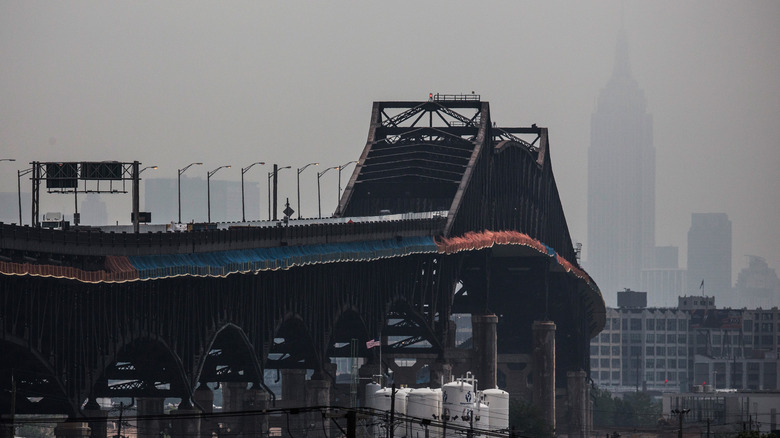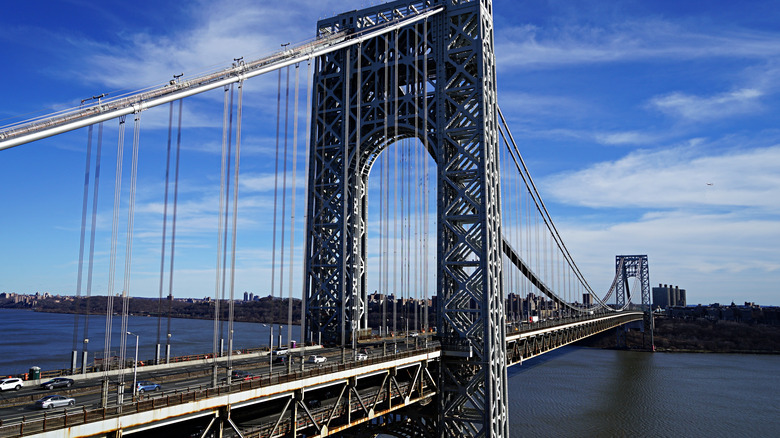The Most Dangerous Bridges In America
Every year the Federal Highway Administration (FHWA) collects data from all federal agencies and state and tribal governments about the bridges and roads on the land they manage. That information is updated on the FHWA website and scrutinized every year by the American Road and Transportation Builder's Association (ARTBA). "The good news," according to ARTBA's 2021 Bridge Conditions Report, "is that the number of [structurally deficient] bridges has declined for the last five years." There were over 1,000 fewer bridges in poor condition in 2020 than in 2019. The bad news is that fully one third of America's 618,000 bridges are in need of repair.
Of course, not all bridges that need repair are dangerous. And not all dangerous bridges need repairs. Some of them do need an exorcism, others could benefit from better weather or less traffic, and some of them just need to explain what's going on because a few of America's bridges are scary.
This article contains mention of suicide. If you or anyone you know is having suicidal thoughts, please call the National Suicide Prevention Lifeline at 1-800-273-TALK (8255).
Lake Pontchartrain Causeway
Louisiana's Lake Pontchartrain isn't very deep — it averages just 12 feet (via NOLA.Curbed) — and the causeway bridge running across it isn't extremely tall or battered by high winds. So why is the Lake Pontchartrain Causeway consistently described as one of the most dangerous bridges in America? One reason is the occasional heavy fogs that descend on the lake that can severely limit driver visibility. The main reason, however, is just that it's a really long bridge.
That's it. As the world's longest continuous bridge over a body of water, notes Atlas Obscura, the Lake Pontchartrain Causeway runs 24 straight, mind-numbingly boring miles. There are no turn-offs and for an eight mile stretch in the center of the bridge, you can't even see land. According to The Travel, "Oftentimes, first-time travelers over the bridge get anxious and stop in the middle of the road and cause major traffic hazards."
The lack of shoulders along most of the road, the complete absence of exit ramps, and the distance to land means any accidents on the causeway ramp up the danger for all other motorists. "I won't go on that thing for anything!" said one New Orleans resident to NOLA. "I drove that bridge before. ... it was the scariest drive of my life!" said another.
Verrazzano-Narrows Bridge
The Verrazzano-Narrows Bridge, connecting Brooklyn and Staten Island, is the largest suspension bridge on the continent. Thirteen lanes of traffic, on two decks, 228 feet in the air — the Verrazzano-Narrows intimidates even professional drivers and is on Freight Waves', a trucking industry magazine, list of most dangerous bridges for truckers. "If I ain't mistaking," said one truck driver, "the Verrazzano makes the elevation of the Mighty Mac [the Mackinac Bridge] seem like child's play."
Compounding the danger, and not mitigating the fear at all, is the gales that blow across the bridge. In 2020 a TikTok video showing the bridge contorting itself in the high winds went viral, and some New Yorkers were asking questions. Fortunately, the New York Post reported, according to the Metropolitan Transportation Authority, "Suspension bridges – particularly the longest span in North America – are engineered to be flexible and any movements on the bridge were within its safety standards."
The combination of high winds on such a structure make the bridge even more of a danger to those who are already a danger to themselves. Even though the Verrazzano was designed without a pedestrian walkway specifically to prevent them, the bridge has seen many suicides and suicide attempts over the years, including at least three in 2020, according to the Brooklyn Daily Eagle. In 2021, the city began putting up strong steel safety fencing to hopefully prevent more.
Can Opener Bridge
Just about every dangerous bridge is a hazard to the cars, trucks, and pedestrians on the bridge. The danger of the Norfolk Southern-Gregson Street Overpass in North Carolina, however, is to those who travel beneath it. The bridge carries no road traffic, only some rail lines, is somewhat shorter than most bridges, and has been destroying trucks driving below it for decades. Despite a plethora of signs erected by the railroad company and the city warning truckers of the bridge's short clearance, trucks still regularly slam into the bridge and have their tops peeled off like a can opener.
Known as the 11 Foot 8 Bridge, or the Can Opener, the truck-demolishing tunnel had been a local celebrity for years when Jürgen Henn, in 2008, set up some cameras across the street to capture an accident, as per Mel Magazine. "Within three weeks I think I had the first footage of a truck crash," Henn explained to Spectrum News 1. He kept getting more and more on film so he started the 11foot8 website to archive the destruction. Can Opener videos were watched by millions online and, after 11 years of increasing mockery online and decades of shaved trucks, the city decided to raise the bridge in 2019 to 12 feet, 4 inches. Not high enough it turns out, as Spectrum News reported in 2021 that the bridge "still finds its own little snack every now and then."
Deception Pass Bridge
According to the Whidbey and Camano Island Tourism website, Washington State's iconic Deception Pass Bridge was built during the Great Depression to make the already popular Deception Pass State Park more accessible. At 28 feet wide, with one lane each way and two sidewalks, the bridge hovers above one of the most beautiful gorges in the state. Handsome cliffs pocked with birds frame waters tense with whirlpools, and colored froth draws artists and photographers from all over the world. Unfortunately, it also draws suicides. According to HeraldNet, there were at least two by July 2021, despite "several suicide prevention efforts at the bridge over the years."
Deception Pass is also frequently smothered in dense fog, as well as occasionally battered by high winds that make walking or even driving across it hazardous. In 2004, reported HeraldNet, a tractor-trailer was pushed nearly off the edge of the bridge by a gust of wind. According to KGMI, the same thing happened during a windstorm in early 2021. To make matters worse, the fog draping over the bridge not only makes it look like ominous, it also forces drivers to slow down when they suddenly can't see, 185 feet in the air above crashing surf.
Fuller Warren Bridge
According to an analysis of data from the National Highway Traffic Safety Administration by international fleet-managing firm Teletrac Navman, four of America's deadliest highways are in Florida. The I-95, even though it slipped from fifth to eighth most dangerous, has been on the list for a while, and Jacksonville has consistently been the most dangerous city on that route. "The Fuller Warren Bridge area" running through Jacksonville, says Florida law firm Pajcic & Pajcic, "appears to be the most dangerous stretch" with over 150,000 cars a day and over 280 accidents in 2015. Someone dies on the I-95, according to the Teletrac report, approximately a little over every two miles. In the Jacksonville section of the road, 48 people die every year.
The contemporary body count is far from the only bloodthirsty shame associated with the Fuller Warren Bridge. The original bridge was finished in 1954, explains The Coastal, and was named after Fuller Warren, the 30th governor of the state. Fuller had been a Jacksonville area politician for a long time before becoming governor. Unfortunately, he was also once a member of the Ku Klux Klan and ran for his "second term as governor on a platform of preserving segregation."
Capt. William Moore Bridge
The small community of Skagway in southeast Alaska is isolated and only accessible by boat or plane and a single road from Canada. The Klondike Highway connecting Skagway to Canada and the world runs over the Moore Creek gorge by the Capt. William Moore Bridge. It is one of the most dangerous bridges in the country because the Moore Creek gorge actually lies along an active fault line, as per Explore North — in the most earthquake prone place in the nation.
Alaska sits on the Pacific Ring of Fire and is the most seismically active place in the country. The Alaska Earthquake Center at the University of Fairbanks "detects an earthquake every fifteen minutes, on average." Three-quarters of all United States earthquakes over magnitude 5 have happened in Alaska, and of the more than 220,000 earthquakes that struck the state over the last five years, 26 were over a magnitude 6. The largest earthquake in American history, and second most powerful ever recorded, was the 1964 Good Friday quake in Alaska.
The largest tsunami ever recorded anywhere in the world, caused by an earthquake, happened less than 100 miles away from Skagway (via the Daily Astorian). The state has been building a replacement bridge for the last four years, however. The National Corrugated Steel Pipe Association reported that it was completed in late 2020 but that "the original bridge remains in place for recreation uses."
The Mackinac Bridge
Michigan's Mackinac Bridge is 5 miles long and so scary, reported Michigan Live, that the Mackinac Bridge Authority created a Drivers Assistance Program to help motorists too afraid to drive across themselves. Connecting Michigan's Upper and Lower Peninsulas, the "Mighty Mac" lies in the middle of a place known for harsh winds and blistering winters, conditions favored by no drivers anywhere. "Each winter," says the Mackinaw Area Visitors Bureau, "ice forms on the cables and towers of the Mackinac Bridge, usually from freezing rain." When those harsh winds blow or the air warms suddenly, that ice can shift, "sending sheets or spears of ice cascading down to the bridge deck below."
These conditions are made more frightening by the 200 feet of air between the drivers and the waters below, as per the Mackinac Bridge Authority, as well as the grated inner lanes, allowing those drivers to see those 200 feet directly below them. Between the high winds battering vehicles of all size and the terrible design decision to make half the road transparent, says Michigan Live, some people actually stop in the middle of the bridge in fear.
So the Drivers Assistance Program was created to help stranded drivers get across. One maintenance supervisor for the Mackinac Bridge Authority told Michigan Live that even after being rescued, "Some people curl up in a little ball and put their head down."
Sunshine Skyway Bridge
The Sunshine Skyway Bridge in Florida has seen a lot of tragedy, technically even before it was built, and is said to be one of the most haunted places in Tampa Bay. The first Sunshine Skyway Bridge was opened in 1954 but had to be completely rebuilt after a freighter collided with it in 1980, causing catastrophic damage and dragging several cars, a bus, and 35 people into the water. "The ghost bus" is often seen by people on the fishing pier, says WFLA. "Many said they feel an actual breeze and even catch a whiff of gasoline from the moving bus."
That wasn't even the first ship to sink at the bridge. Just five months before this crash, the Tampa Bay Times explains, "A freak set of circumstances led to catastrophe," and 23 U.S. Coast Guard sailors drowned after their vessel collided with an oil tanker near the bridge. The new bridge, says Tampa Magazine, was built higher and tougher than the original, able to withstand winds of 135 mph.
Unfortunately, according to WFLA, it has seen over 200 suicides and there have been many strange reports from motorists and people working on the bridge. People described '"a weird unexplained light phenomenon' in the water under the bridge" to an apparition so real that drivers have stopped to help hitchhiking a woman "climbing into cars before disappearing from the passenger's seat."
Astoria-Megler Bridge
The mouth of the Columbia River, known as the Columbia Bar, can be deadly to cross and, according to OPB, is one of the most dangerous sections of water in the world. Treacherous currents and beastly winds lash the river as it meets the Pacific and, says Oregon Live, around 2,000 ships have been lost there over the last 200 years, becoming known as the "Graveyard of the Pacific." As settlements grew into towns and towns into cities, and roads were built between them, people needed to cross the Columbia channel but until the 20th century it was technologically difficult and financially impossible to build a bridge. "They said it couldn't be done" was the cry when the bridge opened in 1966, notes Oregon Live.
Today, spanning the Columbia River between Megler, Washington, and Astoria, Oregon, the Astoria-Megler Bridge sees winds so high they tip rigs over, and commercial truck drivers know to avoid the bridge if they can. CDL Life, a media company for truck drivers and the freight industry, says that "Poor weather conditions make this bridge dangerous. High winds have actually toppled trucks on this bridge." Industry magazine Freight Waves, in its list of America's scariest bridges for truckers, quoted a driver saying that the Astoria-Megler Bridge "is scary in a four-wheeler [ordinary car]. I cannot imagine taking it with a big rig."
Calcasiue River Bridge
Interstate 10 runs across Louisiana's Calcasieu River Bridge over Lake Charles and has needed to be replaced for so long that Travel and Leisure magazine ranked it as America's seventh most dangerous bridge back in 2013, with a sufficiency rating of 9.9% (that's out of 100, incidentally). The Louisiana Department of Transportation and Development (DOTD), reported KPLC, hit back, denying the bridge was unsafe and basically saying "that just because a bridge has a low sufficiency rating, it does not mean it isn't safe." Although, as KFDM reported, the Chamber of Commerce for Southwest Louisiana started a public campaign to replace the bridge in 2018, the following year the Louisiana DOTD issued another statement "saying there is no travel advisory for I-10 Calcasieu River Bridge, and the bridge is safe for travel."
In 2020 however, according to KLFY, the Louisiana DOTD declared that because the bridge "needs to be replaced to meet today's federal highway standards," they have approved a plan to fund and build a new bridge. A year later the Calcasieu was still so bad that President Joe Biden used it for a 2021 photo-op to push his infrastructure bill. The president called the bridge "a perfect example how we've neglected as a nation to invest in the future of our economy and the future of our people" (via VOA).
Pulaski Skyway Bridge
New Jersey's Pulaski Skyway Bridge was called the "Most Beautiful Steel Structure" among American bridges when it opened in 1932. Architectural historian John Gomez told The Jersey Journal it was designed to basically be part of Manhattan: "In a sense, it is a skyscraper. It was the future of cities." The Skyway is tall and slim, and the designer was hoping for a "highway in the sky."
Unfortunately, because of two 11-foot wide lanes in each direction, no shoulders, and a break down center lane known as "suicide lane," the bridge has actually been called the "death highway" for decades. There were so many head-on collisions that the break down lane had a small, ostensibly protective, median added, 20 years later. According to the Constructioneer, the median was eventually upgraded to a larger aluminum one, another 20 years later.
Now, over 90 years on, the Skyway is so dilapidated that the state is spending $1 billion on repairs. The bridge was in worse condition than state transportation officials realized, a New Jersey Department of Transportation spokesperson told the Constructioneer in 2016: "Once the concrete was exposed, the steel under the deck was further deteriorated than we thought." However, the Constructioneer warns, even after the ongoing repairs, "the new bridge may be nearly as scary as its predecessor." There will still be heavy traffic, there still won't be shoulders, and there will still be that "frightening sensation of claustrophobia while driving 135 feet in the air."
The George Washington Bridge
Opened in 1931, the George Washington Bridge (GWB) connects New York and New Jersey over the Hudson River and is an iconic piece of New York City. The bridge graces the opening sequences of countless films and TV shows, and was where Spider-Man's girlfriend was killed. "The George Washington Bridge is more than just a bridge," said New York's governor in a 2021 tweet celebrating its 90th anniversary. "It is an integral part of our region's economy." Which is, if anything, a massive understatement.
According to NJ Spotlight News, nearly 1.4 million vehicles crossed the GWB in 2019, making it the "world's busiest bridge." Being on the I-95, one of the country's busiest roads, also means the GWB is one of the most congested bridges on the planet. Patch reported that, in addition to horrendous traffic, there are over 100 crashes every year on the road getting on and off the GWB in New York City, noting it as super dangerous in comparison to other routes in the country.
The bridge has also been the scene of several suicides, reported WNYC in 2015, when someone tried to kill themselves on the GWB "every 3.5 days." Fencing to deter attempts was installed in 2017, which has lowered the numbers. But even still, according to the New York Times, "a suicide attempt is thwarted at the bridge once nearly every five days."
